Feb. 14, 2017 Valentine’s Day Update: More ways to encourage reading, with therapy dogs (via MindshiftKQED Learning) and a few “Kidlit” picks for Valentine’s Day that streamed across my desk, here and here…Off to my new tutoring gig at Reading Partners.org!
Jan. 16, 2017 MLK Weekend: Book Three of March is out with Andrew Aydin, Nate Powell and John Lewis’ much needed trilogy reinforcing nonviolence in our Trumpian times…#GoodTrouble hashtag is one to follow for certain. Here’s a related post with March included about the power of empathy and storytelling in the hit Ava DuVernay film Selma.
Jan. 17, 2016 Update MLK weekend The 2016 Newbery & Caldecott awards for ‘best children’s books’ are out, and I can’t help but think, “How do we create ravenous readers, who WANT to pick up books just for fun?”
In addition to the graphic novels of the “March” series, and marketing tactics cited below, Scholastic adds this post to help encourage reluctant readers and boost kids’ reading confidence, by reading to the dog, making a game of it, adding crafts (as we did in our book club) and more. Enjoy!
Feb. 18, 2015 Update Excited to hear from civil rights leader and Congressional Representative John Lewis at S.F. State today speaking about using graphic novels as a gateway to learning and educating about non-violent values in protests against segregation.
Rep. Lewis has written March Book One and March Book Two (released Jan. 20, 2015) with Andrew Aydin and Nate Powell and seeing this BBC Sports clip just this morning of a black man being denied entry into a subway in Paris by the pack mentality of rabidly racist Chelsea football fans reinforces my resolve that these graphic novels aka cultural “comics” need distributed widely…early and often to get kids schooled in non-violent confrontations amidst a cultural credo that tolerates the opposite.
I sincerely hope that with today’s media devices and facial recognition, they hunt down these miscreants, ban them from their beloved sport for their conduct, plop them into mandatory community service education in racially charged environments to learn empathy, and inch towards teaching tolerance through experiential hands-on inclusion. Ugh. There’s no place in sports OR society for this conduct. (Note: New Reading Research from UCSF in the New Yorker this week on “How Children Learn to Read”)
Original Post Aug. 27, 2011 Last week the NYTimes Arts Beat ran a solid session on reluctant readers with an extra oomph of focus on boys, GuysRead.com style tips about literacy lag and an interesting video of uber-authors James Patterson (Read, Kiddo, Read project; the Maximum Ride series) and Rick Riordan (the Percy Jackson series).
Aside from the NYTimes’ sensationalized “Boys and Reading: Is There Any Hope?” headline which seemed to be a self-defeating hook to glean more eyeballs, it DID make me think a lot about the messages pummeling kids about reading as if it were a Mary Poppins tune “Just a Spoon Full of Sugar” (makes the medicine go down)…How can we flip the media message about reading into a pleasurable, positive, fully immersive and experiential mind candy point of view instead of cramming it into “mandatory/required” verbiage leaking into ‘summer fun?’
What kind of joy juice allure and coolness cache can be used to replicate the Harry Potter and Twilight series rabid reader pop culture phenom in peer to peer ‘viral marketing?’ What tried and true basic tips (like BIG print and lots of white space for early readers) have worked time and again?
In Part One, ravenous reader Kalimah Priforce uplifted himself in almost ‘superhero’ mode with his foster home tale, (which is itself a branding strategy we can use for inspiring reluctant readers, “aspirational marketing”)…So today in Part Two we’re tossing out a few strategies for enticing the opposite faction: the heel-screeching, ‘can’t make me/don’t wanna’ style of reluctant readers as well as those simply needing a nudge.
How can we best seed success using MARKETING tactics, verbal cues, and yes, even ‘trial sizes’ and freebie fun. Ready? Find out what will happen if you…
SIKE! … Made you look. See what I mean? That was a marketing tactic…A teaser approach. (Cue obnoxious taunting from your favorite tween)
Truth is, teasers as entertainment vehicles are just like the page turning prompts authors use to read ‘just one more line’ by bridging chapters with cliffhangers and triggering ‘tune in next week’ drama for suspense.
So why can’t we ‘tease out’ the motivations and triggers that get kids’ excited about stories, much like read aloud teachers close the book with a coy, “we’ll finish this up next time.” It’s brilliant and it works.
Before suggesting positive pathways using media and marketing cues, I’d like to shoutout a huge “unschooling given” to be aware of…There’s a difference between using marketing tactics from a clean slate of neutral (no bias) versus the need to “counter-market” (definite bias you’re striving to change).
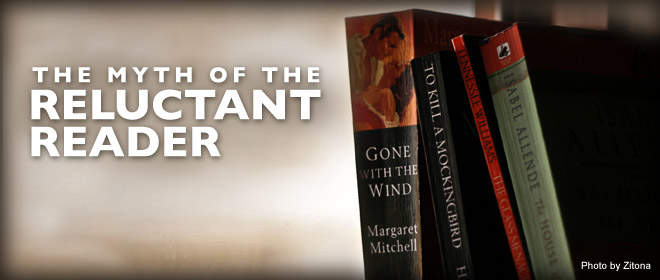 Educators, your power to project pre-determined responses is key here…
Educators, your power to project pre-determined responses is key here…
I’m talking about the medicinally marketed (and much maligned) “mandatory reading lists” which smack of drudgery and are bound to get pushback in favor of a rebel yell for freedom and a stronger sense of agency. So, again: Does your reluctant reader perceive the task as ‘negative/positive or neutral?’
Do you even believe in the phrase ‘reluctant reader’ or has your child just not yet glommed onto the right books?’ (fabulous post by author Jon S Lewis on this ‘myths’ topic along with 25 of his own picks for reluctant readers)
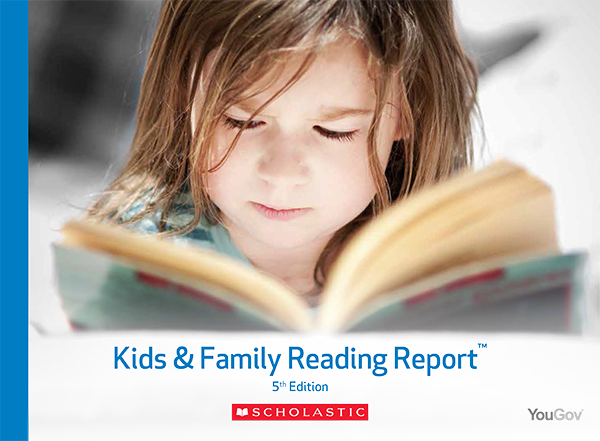 Scholastic’s Kids & Family Reading Report (5th edition links here) cites “86% of kids feel proud and have a sense of accomplishment when they finish reading a book,” yet the concept of “required” often tarnishes the experiential joy of pure ‘pleasure reading’ only to become yet another ‘to do list’ plopped onto kids’ slates, which can kill self-driven learning, particularly with reluctant readers.
Scholastic’s Kids & Family Reading Report (5th edition links here) cites “86% of kids feel proud and have a sense of accomplishment when they finish reading a book,” yet the concept of “required” often tarnishes the experiential joy of pure ‘pleasure reading’ only to become yet another ‘to do list’ plopped onto kids’ slates, which can kill self-driven learning, particularly with reluctant readers.
It’s odd how our society talks about the damage to lifelong learning by creating robo-students “Doing School” in harried, hurried child mode, yet then proceed to layer on stresses to “keep up.” Even if “must reads” are rebranded as “Recommended but not required” or “Suggested summer reading for success” it’s still masking performance-driven benchmarks that are the kiss of death in the media mix of choices, ESPECIALLY for reluctant readers.
Guess that’s why prickly parents (er, me) choose to blow off the strong-arm approach in the name of free time, free agency, free thinking, and fresh branding of the concept of reading as ‘entertainment.’ After all, part of the popularity of Potter/Twilight and such is that it represents the antithesis of ‘required reading’…
I’d far prefer kids’ choices and pleasure reading to instill that wondrous feeling of immersion when children feel like they’ve landed in an alternate world of experiential new discoveries.
Reading and imagination have been a “virtual world” of wireless, mobile, interactive engagement LONG before computers and digital enhancements ever came along.
So how can we further ‘tease out’ the DESIRE to read…Especially if there ARE ‘state standards’ and ‘lists’ that need addressed with older kids? Getting Boys to Read.com (in beta) asks, “What’s the best way to encourage kids to read classic novels?” Since this is an entertainment industry/marketing tactics post I’ll toss in:
What if we try to view books as the “movie trailers of the mind” and seed some of the content forthcoming? Preview passages that are particularly dramatic, salacious, or controversial with tweens/teens in ‘banned book’ style? Use transmedia and social media elements to turn reading into a ‘happening?’
For reluctant readers, triggering that drive and desire is a behavioral must.
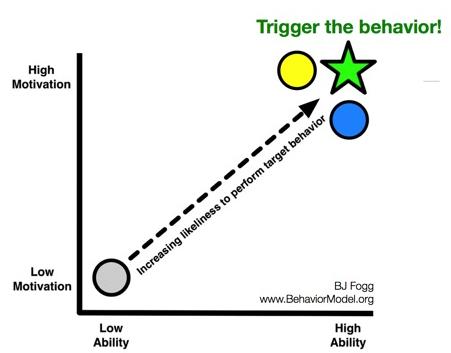 Here’s an introductory overview using Stanford Persuasion theorist BJ Fogg’s behavioral change model. In order to have “success” three elements must converge at the same time:
Here’s an introductory overview using Stanford Persuasion theorist BJ Fogg’s behavioral change model. In order to have “success” three elements must converge at the same time:
Motivation, Ability, and Trigger.
I play with this concept a considerable amount in counter-marketing, because it’s not ‘just reverse psychology’ it’s a nuanced understanding of hot buttons and personality types in each individual child that can make it a ‘flip’ of the message or a ‘flop’ of the effort. Everyone will have a different learning style to engage most effectively no doubt, so I’m just going to toss out what’s worked here a tad.
1.) Kids’ Choice: The Power of Preferences
Even though my daughter’s first grade class LOVED the Junie B. Jones series, I deplored it, for the sass-mouth cues and grammar twist-ups like ‘bestest and funner’ which make me cringe…As a writer, I kept thinking about how complicated the English language is WITHOUT kids learning to read with non-existent words.
 Like FCC television bumpers, the ability to discern media fact vs fiction before age eight is muddled; so to me, Junie B. Jones equated to the black & white defacto “see it in writing and insist the word exists” first grader mindset—a mixed media message at best, and at worst, an illiterate dumbing-down farce.
Like FCC television bumpers, the ability to discern media fact vs fiction before age eight is muddled; so to me, Junie B. Jones equated to the black & white defacto “see it in writing and insist the word exists” first grader mindset—a mixed media message at best, and at worst, an illiterate dumbing-down farce.
The more my daughter was exposed to those books at school, the more she began to talk that way and behave that way, which made me wince and pretty peeved. Last thing I needed was cruddy media cues making my life more difficult. And of course, the more I winced, the more my daughter would push my button to want it even more. I approached our beloved wise owl teacher, since I had ‘issues’ with it, and literally couldn’t bring myself to read it aloud to her, returning a gift set unopened one birthday. The teacher imparted some sage advice that’s served me well a decade later,
“You don’t have to like it. And I can see why you resent it coming from school. But ANY hook to get kids reading is a good one— You can correct the grammar and the behavior, but reading is a life skill she can’t do without. I’ve found kids love this character’s mischief…they bond with her, and it can actually keep them fom acting out long term, if they can escape into their world in the pages in the book.—Like any media coming at kids, if you put heat on it or ban it, they’ll find it elsewhere.”
Sure enough, Scholastic’s report cites “The power of choice is a key factor in raising a reader. Nine out of ten children say that they are more likely to finish book they choose themselves. Parents don’t try to overly influence that choice toward award winners or classic literature. Nine out of 10 parents say “As long as my child is reading, I just want my child to read books he/she likes.”
(Quel surprise, I was the outlier parent…But I’ve learned to see the positives in the ‘let them eat cake’ philosophy.)
2.) Forbidden Fruit Factor: Tweens/Teens Allure
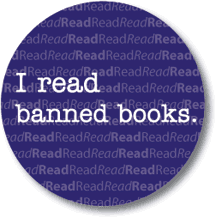 Marketers use this tactic early and often, which drives parents like me nuts (especially in this age compressed tween and teen world where it’s used very overtly to undermine our authority—e.g. Electronic Arts’ “Your Mother Hates This” microsite/ad campaign) so why not ‘fight fire with fire’ and use that strategy for GOOD to entice ‘flashlight under the covers’ style enthusiasm for reading?
Marketers use this tactic early and often, which drives parents like me nuts (especially in this age compressed tween and teen world where it’s used very overtly to undermine our authority—e.g. Electronic Arts’ “Your Mother Hates This” microsite/ad campaign) so why not ‘fight fire with fire’ and use that strategy for GOOD to entice ‘flashlight under the covers’ style enthusiasm for reading?
Draw on the subversive messages front by choosing from YALSA’s Banned Books list, with librarians across the country celebrating Banned Books Week this year Sept 24−October 1, 2011 —Parents, you’ll be surprised seeing some of your own childhood reads landing on this list. (meanwhile Snooki grinds with a houseplant? Sheesh, I dunno how media decisions are made lately, truly mind-numbingly surreal)
Granted, some of these are classics so ‘abridged versions’ for reluctant readers might be more apropos, but the other ‘hook’ is to position pleasure reading in your own home using these marketing tactics…Key words for me?
“Not sure if this is appropriate for you yet, but…”
Whammo. Book is gone. Read. Digested. Often in a 24 hour power-read mode.
—Just happened with Jay Asher’s Thirteen Reasons Why about a character who committed suicide (which will soon be made into a movie with Selena Gomez cast as the lead, and by the way, Jay Asher is hosting this year’s YALSA Teen Read Week coming up Oct. 16-22, 2011) Another instance?
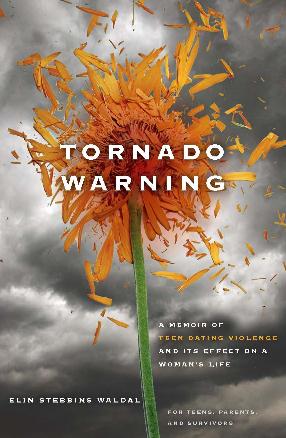 I had a pre-publication copy of Elin Waldal’s Tornado Warning about teen dating violence and made it clear it was ‘meant for adults to open conversations with teens, not intended for teens directly’…
I had a pre-publication copy of Elin Waldal’s Tornado Warning about teen dating violence and made it clear it was ‘meant for adults to open conversations with teens, not intended for teens directly’…
Of course, my 16 year old swiped it from me countless times.
In fact, I’d usually find it under her bed having read it as she drifted off to sleep, and we finally ended the cat and mouse game, passing the manuscript back and forth with feedback and conversations like a Hollywood tandem team working on a fall season pilot. Success!
By the way, check out the new Love Is Not Abuse free mobile app, quizzes and downloadable curriculum to educate youth and parents about the ‘warning signs’ of an unhealthy or abusive relationship…guys, girls, or any combo thereof. It’s a smart intervention to raise awareness, as reviewed here. (I’m about to download it now and check it out as author Elin Waldal is a regional brand ambassador.)
3.) Packaging Sizzle: Over-sized, Mini-Books & Make Your Owns
Marketing geniuses often downsize miniatures and upsize costs ‘cause their ‘cute’ (works in food and beverage category too; ‘cute’ bran muffins are much more palatable in trial size miniatures to finicky eaters ) so books can be eyecatchers to instigate exploration here too…
Ever seen those humongous almost life-sized books in the kids’ section of the library that kids gravitate toward? Or the teeny weeny Golden Books sold in Costco size quantities that I’ve used for Halloween treat giveaways?
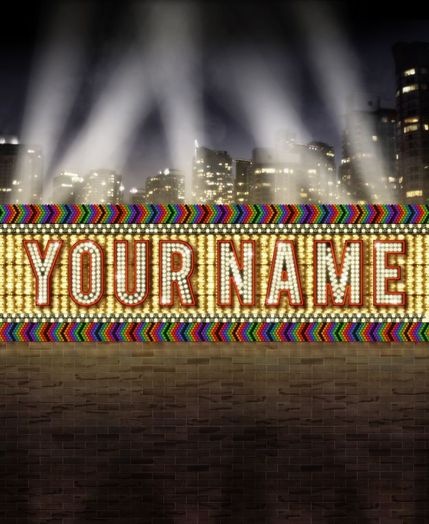 “Your name up in lights” do-it-yourself customizable books are fun for children who like to ‘be the star’ of their own stories with a few clicks and a printer too.
“Your name up in lights” do-it-yourself customizable books are fun for children who like to ‘be the star’ of their own stories with a few clicks and a printer too.
There are a wide array of fancy schmansy offerings and keepsakes adding friends and family to personalize the basic plot points around loved ones. (here are about 20 to wade through, but as a writer I’ll add my caveat, if it’s a crummy story no amount of gimmickry will make it readable so choose wisely)
Still, my own daughter has an unusual name, so when she used to see it ‘in print’ it amped up the storytelling factor and she’d ask for that one often. (particularly helpful when the subject eased tension on topics like going to the dentist or starting school…helped in ‘you are there’ mode to diffuse some of the angst)
4.) Customization: Story Starters & Creative Digital Play: SuperWhy, Storybird & more
 No secret that I LOVE it when digital creativity boosts reading engagement, whether it’s with MadLibs (lots of great interactives and free web reads at FunBrain) or PBS Reading games or children creating customizable ‘stories’ in plop and drop informal learning meets gaming fun, with PBS SuperWhy’s many offerings including the SuperWhy Storybook Creator. (full story to come when I write the digital positive picks, but hint, these are all on the list!)
No secret that I LOVE it when digital creativity boosts reading engagement, whether it’s with MadLibs (lots of great interactives and free web reads at FunBrain) or PBS Reading games or children creating customizable ‘stories’ in plop and drop informal learning meets gaming fun, with PBS SuperWhy’s many offerings including the SuperWhy Storybook Creator. (full story to come when I write the digital positive picks, but hint, these are all on the list!)
With a 21st century education revolution in full swing, and kids gleaning access to multiple methods of learning, there’s a bounty of digital innovation to turn reluctant readers into ravenous ones.
One of my favorite sites for collaborative and participatory reading is Storybird where kids can use art to create their own stories “from scratch” and even “publish” their books for an added sense of DIY glee. (Storybird is featured on Shaping Youth here)
(I’ll address the iPad, kids’ apps and additional screen time media in a separate post)
5.) Incentives & Rewards: The ‘Gamification’ of Reading
Similarly, even though, alas, we saw the fizzle of SmartyCard.com which once upon a time exchanged ‘learn to earn’ points and rewards for media time in virtual worlds and such. Still, I think there’s a huge ‘incentives’ market that can replace the ‘coinage and consumption’ model with personal progress and privileges replicated online or offline.
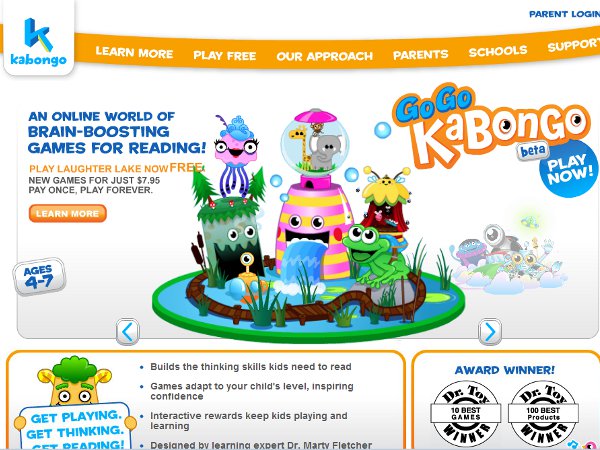 Mind you, this type of online gamification with levels, badges and rewards is pretty common now with younger kids jumping through hoops to participate in school or summer reading/rewards programs or online sites “Get Playing, Get Reading, Get Thinking” of the new Kabongo.com for ages 4-7.
Mind you, this type of online gamification with levels, badges and rewards is pretty common now with younger kids jumping through hoops to participate in school or summer reading/rewards programs or online sites “Get Playing, Get Reading, Get Thinking” of the new Kabongo.com for ages 4-7.
Admittedly, I can get ‘old school’ in a flash when I think about ed tech gizmos and the future always wondering if kids are going to someday look up from the pages of a traditional book and say, “ok, but what does it DO?” (delightful picture book along those lines to reinforce that theme called Press Here by Herve Tullet) but since I’m headed to Silicon Valley “Apps for Kids” Monday night to hear all about 3-D from a Hasbro inventor, I’m clearly in the “whatever works” camp of instilling a love of reading as a life long companion.
I just want to see those snuggle in, drop down into a comfy couch, seal off the world moments to transport yourself inside the pages of a book transformations happen, no matter what media it takes to get there.
My hunch is no tchotchke or point chart incentive or electronic badge will ever duplicate that feeling of satisfaction, peace, and natural escapism.
Rather than view the digital web and e-books/mobile apps as a threat to reading, it appears to be quite the contrary, citing the Scholastic survey again:
“The study found indications that technology could be a positive motivator to get kids reading — 57 percent of kids (age 9-17) say they are interested in reading an eBook, and a third of children age 9-17 say they would read more books for fun if they had access to eBooks on an electronic device. This includes kids who read 5-7 days per week (34%), 1 to 4 days per week (36%) and even those who read less than one day per week (27%). The findings from the Kids and Family Reading Report indicate that the ebook market will continue to grow…”
6.) The Drop Zone: Informal Fun & Freebie Finds
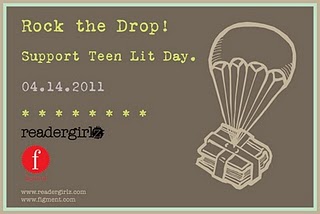 I’ve tried the YALSA Teen Book Drop approach of ‘leaving books behind’ to be discovered, akin to the Read Kiddo Read site that prompts, “Leave these great summer reads on the backseat. After a few bored miles down I-95, your kids are sure to peek past the covers of these winning books, and instantly be hooked.”
I’ve tried the YALSA Teen Book Drop approach of ‘leaving books behind’ to be discovered, akin to the Read Kiddo Read site that prompts, “Leave these great summer reads on the backseat. After a few bored miles down I-95, your kids are sure to peek past the covers of these winning books, and instantly be hooked.”
In my family, sometimes it works, sometimes it doesn’t, depending on the subject matter, strategic placement, relevance, and degree of casual mention.
For what it’s worth, the 2010 Kids & Family Reading Report stated, “For older kids, parents used ‘making sure there are interesting books in the home’ (effective for kids age 9-11, 15-17) and ‘suggesting books they might like’ (effective for kids age 12-14) as ways to encourage more reading.
7.) Invitation Only: Feeling of Belonging, Clubs & Social Reads
 Online marketers are known for their contests, “loyalty” perks and making kids feel ‘special’ by inclusion, flattery, and commonalities. Likewise, book clubs and social circles are a given for matching up skill sets…Or, conversely, mixing it up with different levels of readers for “aspirational” marketing, to push the envelope of ‘what’s next.’
Online marketers are known for their contests, “loyalty” perks and making kids feel ‘special’ by inclusion, flattery, and commonalities. Likewise, book clubs and social circles are a given for matching up skill sets…Or, conversely, mixing it up with different levels of readers for “aspirational” marketing, to push the envelope of ‘what’s next.’
We tried this with my own reluctant reader keeping the focus of the club on fun, and mixing up reading levels and personalities. It became a highly creative, all girls ‘book club’ tied to crafts and activities enmeshed with the theme, rotating houses to host like a social party. (We did this with math club too, using pizza for fractions and all that fun yummy stuff)
As the girls got older (tweens) they picked the monthly theme/activities themselves and owned their role in who created the coolest ideas, which segued into a bit of a competition, albeit a healthy one for ‘not wanting to miss out’ on book club.
As they ‘aged up’ their reading skills and interests ‘forced’ a bit of overlap, with comparison contrasts of movies/books. Eventually the girls branched off to other schools and lifescapes, reuniting more for the ‘social’ than the book…informal learning of a different kind.
Online, YA (young adult) fiction reading clubs like Readergirlz bring music, author chats and global reading into an experiential opportunity, with some using Twitter feeds-n-reads to host their own convos, “parties” and ‘giveaways’ sometimes sponsored by book publishers with freebies. (not for ‘reluctant readers per se, but I’m talking about using this as a model to find same)
8.) Superhero Spin: Real Life Stories With a Comic Book Feel
Just like HBO launched their new SuperHeroes Documentary about real life crusaders against crime we’re seeing graphic novels as a category skyrocket with the creation of epic biographies giving real heroes the ‘comic book treatment’ through the works of anime greats like Eiji Han Shimizu (see Ode Magazine’s Real Hero Comics, a fabulous write up citing graphic novels from Anne Frank to Mother Teresa) as well as my prior post about Meaningful Manga with Gandhi, MLK and several offerings available at Reach and Teach.com.
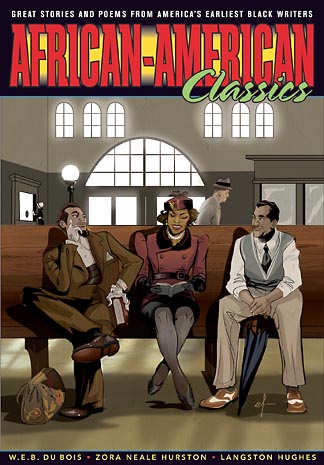 New graphic novels coming onto the scene this December 2011 include Black Superhero.com’s “African American classics” featuring 23 stories and poems by America’s earliest black authors and artists to add to the indie comics arts and culture genre of graphic novels many librarians have cited as using in school for reluctant readers.
New graphic novels coming onto the scene this December 2011 include Black Superhero.com’s “African American classics” featuring 23 stories and poems by America’s earliest black authors and artists to add to the indie comics arts and culture genre of graphic novels many librarians have cited as using in school for reluctant readers.
Excellent roundups of resources in this genre include “Using Graphic Novels with Children and Teens: A Guide For Teachers & Librarians” by Scholastic, Education World’s “Eek! Comics in the Classroom!”
“Can the X-men Make You Smarter?” at Parents Choice.Org as well as The Comic Book Project (arts based literacy and learning initiative from Center For Educational Pathways)
I’ll do a separate post on 2011-2012 picks in the reluctant reader graphic novel realm, but just know that I think they ROCK for early reading (says the Charles M. Shultz addict of age 8 who once upon a time read collected an entire case of Snoopy books when we lived in Japan and I had no other media I could understand initially) heh.
9.) Peer to Peer WOM (Word of Mouth) Marketing and Celebrity Spokespersons
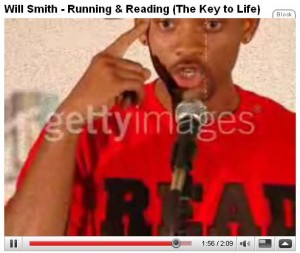 On the celebrity front, Will Smith made waves as a positive influence at the Nickelodeon Kids’ Choice awards giving his life lessons about “Running and reading= The Key to Life.”
On the celebrity front, Will Smith made waves as a positive influence at the Nickelodeon Kids’ Choice awards giving his life lessons about “Running and reading= The Key to Life.”
Great video message and example of aspirational celebrification that works to engage reluctant readers.
From celebrity readers in niche interest areas to larger than life advocates for literacy, using starpower to hook the starstruck is one way to spin the spotlight in a positive direction.
Peer to peer ‘viral marketing’ is a given, since the pass around pack of book picks becomes a pop culture ‘did you see it/did you read it?’ conversation starter, just like YouTube videos make the rounds.
Walk through the aisles of a 747 sometime and keep an eye on how ‘viral reading’ catches hold. At one point I recall counting eight passengers all reading The DaVinci Code just making my way to the restroom…then it was Eat, Pray, Love…the next round, etc. This same viral impact can really “take off” when seeded well as even reluctant readers are swayed by peer panache…
Sure, we can thank Harry Potter and Twilight and the Tolkien trilogies for engaging imaginations…but why not seed it casually in your own home or classroom among ‘peer influencers’? My own daughter’s BFF is like a personal lending library in terms of pass around mode. It not only jumpstarts the ‘I know you’ll like this’ fab-find factor based on personality type, it amps up the peer evaluation dynamic reassuring it ‘won’t be a waste of time.’
10.) Gimmicks, Giveaways, BOGO, Street Teams and High Touch vs High Tech
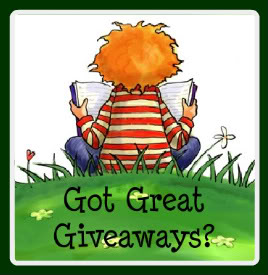 Just like food and beverage companies give out ‘samples’ there are tons of freecycling opportunities for schools and communities to rally around in either ‘buy one give one’ mode, or sheer donation free-for-all, literally giving out books in the streets. (everyone likes freebies, you can organize one of these events in a snap)
Just like food and beverage companies give out ‘samples’ there are tons of freecycling opportunities for schools and communities to rally around in either ‘buy one give one’ mode, or sheer donation free-for-all, literally giving out books in the streets. (everyone likes freebies, you can organize one of these events in a snap)
Street teams, flash mobs and other ‘public draws’ that outreach to kids where they least expect it are the 21st century guerrilla marketing for reading vans.
Whether it’s groups like Erin Gruwell’s real life Freedom Writers meets movie media (perfect use of journals and diaries) making guest appearances or for urban youth, ‘at risk’ touting literacy in ‘show and tell’ turnaround form for a classroom, there are countless ways to blend the tactics of marketing literacy into reluctant reader formats.
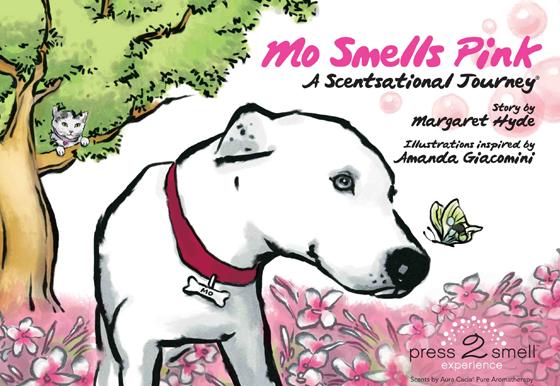 Scratch-n-sniff books and Pat the Bunny may feel like they’ve given way to sproing sounds and audio bleeps from iPads and iPhones but creative innovations like this are definitely still great first starters for reluctant readers…
Scratch-n-sniff books and Pat the Bunny may feel like they’ve given way to sproing sounds and audio bleeps from iPads and iPhones but creative innovations like this are definitely still great first starters for reluctant readers…
This new “Mo Smells Pink-Scentsational Journey” was SELF-published in aromatherapy mode, adding a whole new entrepreneurial angle to the future of books sans traditional publisher. (Imagine the reluctant reader allure if this went completely custom down the line…whoa, talk about the future of the book, with QR codes and scents!)
Finally, try on tactile as a tactic when it comes to touch and feel sensory books.
One of my favorite ‘draws’ in terms of gimmicks continues to be lift the flap books (moreso than pop ups which always seem to tear and get trashed or ‘stickers’ to add to finding factoids in early readers). Moreover, the tug the tab reveal style books of tactile treasures (like the rhyming series of animal rainforests, oceans, and forests by Maurice Pledger) always kept my own daughter entertained longer when learning to read aloud in high touch sensory picture book mode.
What works for you to instill a passion for reading? Youth? Adults? Teens? Kidlit pros? And what does that passion for reading look like, by the way?
Do pouring over blog posts and text chimes constitute reading?
As I asked in this post, “Is There A Decline In Reading, Or Is It Just Shifting Forms?”
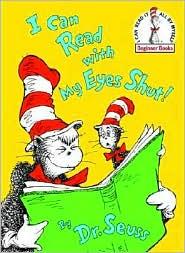 That same Scholastic survey notes 28% of kids (ages 9-17) think that looking through postings or comments on social networking sites like Facebook counts as reading; whereas only 15% of parents agree. Others feel social media usurps precious reading time altogether.
That same Scholastic survey notes 28% of kids (ages 9-17) think that looking through postings or comments on social networking sites like Facebook counts as reading; whereas only 15% of parents agree. Others feel social media usurps precious reading time altogether.
I’m in the read ‘any, all, and often’ point of view using every possible literacy “hook” online and off to give kids a solid “why to buy.”
As Dr. Seuss wrote:
“The more you read, the more things you will know. The more that you learn, the more places you’ll go.” – “I Can Read With My Eyes Shut!”
p.s. Until I can get my post prepped on the multitudes of digital offerings for both reluctant, ravenous, and regular readers…here’s more from an excellent resource at PBS kids (you can download the pdf and watch for the film Digital Media: New Learners of the 21st Century in your region)
Update: Nov. 29 Don’t miss fresh, fun ways to gift books to kids plus StorySnoops reluctant reader list for tween girls and this one for tween boys ages 9-12!
And…Just For Fun…(I absolutely love this!)
Visual Credits: Lead Graphic from TutoringMontana.com, Myth of the Reluctant Reader photo by Zitona via author Jon S. Lewis’ blog per links in content above, Your Name photo from ArtInAmericaMagazine.com, Got Giveaways from Photobucket via I Am A Reader, Not A Writer blog
Related Resources for Reluctant Readers
Inspiring Reluctant Readers: VIDEO w/James Patterson & Rick Riordan (NYTimes)
Guerrilla Tactics To Get Your Child To Love Reading (Imagination Soup)
Choosing Children’s Books For a Reluctant Reader (Scholastic)
Helping Reluctant Readers (Kids Health.org)
Top 5 Ways to Motivate Your Child to Read (About.com)
Resources for Reluctant Readers (roundup)
American Library Assn: Quick Picks for Reluctant Readers
A Few Related Reading Topics On Shaping Youth
Reading Rockets Kids Into Their Future (Part One)
Is There A Decline In Reading, Or Is It Just Shifting Forms?
First Person Storytelling: The Real Deal Impacts Youth
Will Smith’s Running & Reading KidVid Endures: Teen Read Week
Operation Teen Book Drop Supports YA Lit With Street Teams
Freecycling Kids Books & More Book Swap Resources
Shaping Youth Interviews YALSA President for Teen Read Week
Twilight Teens, GirlChild Press & A Reading Manifesta: Read, Kiddo, Read!
Teens Shout Out A Rebel Yell for Banned Books Year Round
Teen Book Publishers Premiere Louder Than Words TV
Readergirlz Diva: Love Yourself Share Your Story
Shaping Youth: YA Books Become a New Media Experience
Ideas For World-Changing: Go Overboard!
31 Flavorite Authors for Teens: readergirlz Teams With YALSA!
Leave Books In Public Places: Rock the Drop For Teen Lit Day
Teens Shout Out A Rebel Yell for Banned Books Year Round
Creating a Better World Through Books, Reading
(help me build this list with your recos in comments, pls?)
JumpStart.org (w/Pearson Fnd; Read for the Record is 10-6-11 this year)
YALSA/ALA’s Teen Read Week(10-16 thru 10-22-11 this year)
ALA Banned Books Lists (Banned books week is 9-24 thru 10-1-11)
National Children’s Book and Literacy Alliance
Reading Rockets.org (Launching young readers, helping strugglers)
Reading Rockets.org NEW MOBILE APP
- YALSA Book Lists & Book Awards
- ALA: Best Books for Young Adults
- ALA: Fabulous Films for Young Adults
- ALA: Great Graphic Novels for Teens
Reading is Fundamental (Congress cut RIF.org funding, act now here)
PBS Kids.org/Read (Word quests, reading adventures, interactives)
Read.gov/kids (Extensive book lists and reading resource compilations)
Electronic Books & Online Reading (Teacher Tap/Eduscapes)
PBS Kids Reading Games (Great Selection of Online Reading Games)
Reading Games, Resources, Children’s Books (Edu-Cyberpg.com)
Read Kiddo, Read.com (Author James Patterson’s site/Dedicated to making kids readers for life)
Scholastic.com (Read everyday/lead a better life–global literacy)
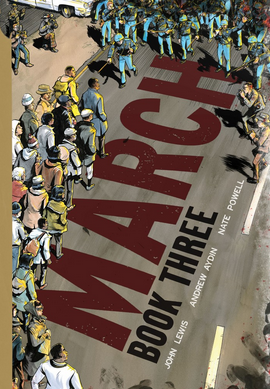
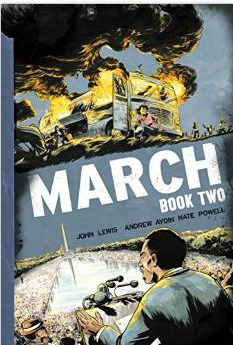
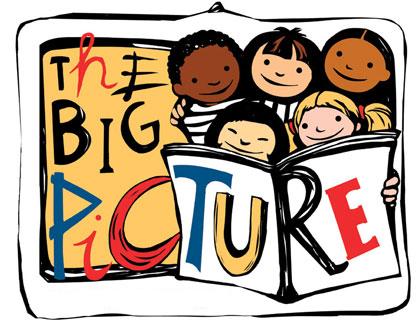









Reading is the spice of life. I believe when Malcom X said, “By any means necessary” people assumed it was violence, but this was a well read man. That was one of his greatest lessons that you have to become educated in order to not be gullible as he was with the Nation of Islam and the person he looked up to in the Nation. Read. How many artists have been bamboozled because they did not read their contract. Read. How many people are lead down the wrong path because they watched the news instead of reading the information for themselves. Do what you must to get your teen to read. It is one of the greatest gifts you can give someone how much more your teen?
Eleanor Roosevelt once said, “No one can make you feel inferior without your help.” When you have no desire to learn for yourself, you help people make you feel less empowered, weak and powerless. Pick up a book, magazine, article and empower yourself to overcome, learn and grow mentally, spiritually and beautifully! By reading the stories of others your teen can become inspired to be the best they can be.
Dr O from TheTeenDoc.com
Creating a Better World . . . suggestion — Dia de los ninos, Dia de los libros/ Children’s Day, Book Day. It’s all about famility literacy. See http://www.patmora.com/dia and http://www.ala.org/dia.
Thank you! Will add it! Appreciatively, Amy
Must say Kemi, I never equated the Malcolm X quote with reading, but I will remember this one from now on! Love your passion on the subject…
Great Website! I’m always looking for the best ways to raise my two daughters.
I would like to say thanks for publishing such information here with us and this article is really helpful for parents and their kids. When I start to read your blog I found it very interesting for me. I have two kids one girl and another is boy and I am sure I’ll grow up my kids in this way.